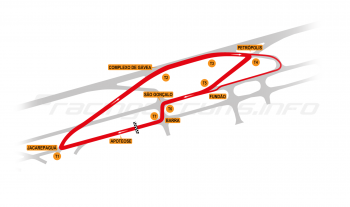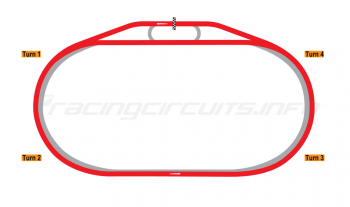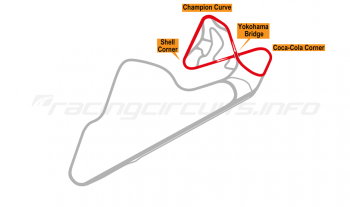Riverside
Circuit Overview
Riverside International Raceway (sometimes known as Riverside, RIR, or Riverside Raceway) was a hot, dusty and at times dangerous place, yet it is remembered with affection as the home of road racing in southern California and one of the USA's finest tracks.
The Los Angeles urban sprawl would eventually put the facility out of action – to be replaced by housing and a shopping mall – but not before more than 30 years of racing memories had been set.
Plans were mooted for a new course in the image of Riverside in Merced, California but these were finally abandoned for financial reasons in 2009. Today, Southern Californian racers make do with Auto Club Speedway at Fontana and Toyota Speedway at Irwindale. Both are fine modern facilities but lack the essential soul of the old blast through the desert.
Circuit History
The circuit owes its existence to a German-born immigrant, Rudy Cleye, who moved the US in the 1940s, initially working as a maitre d' at the Diamond Horseshoe and the Riviera in New York, before moving to California to set up a restaurant. Cleye had dabbled in sports car racing back in Europe, so with the sport burgeoning in the USA, it was no surprise that he should get involved. He organised the West Coast Automotive Testing Corp, which set its sights on finding a solution to the lack of permanent racing facilities in California.
Construction on a new course began but, as is often the case, the organisers ran out of money and the track did not become a reality until industrialist John Edgar bailed them out with a hefty bankroll. Finally, in 1957 Riverside International Raceway was ready for action. Set in the desert near the San Bernardino mountains east of Los Angeles, the course wound around the natural topography through a series of challenging esses before entering a long downhill back straight, almost a mile in length. A banked final turn tested the braking packages of the cars to their limits (and often beyond) before returning the racers to the start/finish.
Early beginnings
The first event took place on September 21, 1957, a California Sports Car Club event. Richie Ginther and Ricardo Rodriguez won the opening day twin features for sports cars. Remarkably, Rodriguez was aged just 15 at the time and thus too young to drive on California's highways. The racing director had to obtain special permission from the highway patrol for Rodriguez to compete...
Sadly the opening event also chalked up the circuit's first fatality, when John Lawrence of Pasadena, California, lost his life at Turn 8. Lawrence, a former Cal Club, under 1500 cc Production champion, lost control of his MG A and went up the sand embankment, then rolled back over onto the track. With no roll bar on the car, Lawrence struck his head and although he only appeared slightly injured at the scene, he died later at the hospital of a brain injury. It would not prove the last death at Riverside, which would claim the lives of further prominent racers during its time.
The second event, held in November 1957, proved a happier occasion and would provide the springboard for one local racer's international career. The sports car event attracted the top drivers of the day including Carroll Shelby, Masten Gregory and Ken Miles. But it was Riverside's own Dan Gurney who stole the headlines, battling for the lead in an ill-handling 4.9-litre Ferrari which he had only been invited to drive when Shelby and Miles turned it down.
Shelby led early but spun and fell back, handing the lead to Gurney, which he held for much of the event until Shelby fought back and eventually overtook the Californian late in the race. The watching North American Ferrari importer Luigi Chinetti was impressed, however, inviting Gurney to drive a factory-supported Ferrari at Le Mans in 1958. It would effectively launch Gurney's European career and ensured his fame at his home circuit – known by many as the 'track that Gurney built'.
In 1958 the inaugural Los Angeles Times-Mirror Grand Prix was held, the first time an automobile race had been sponsored by a major metropolitan newspaper. The association would last right the way through the circuit's dying days. Chuck Daigh, in one of Lance Reventlow's Chevrolet-powered Scarabs, won that race after a battle with Dan Gurney, in Frank Arciero's Ferrari, and Bill Krause, in a D-type Jaguar.
NASCAR and F1 arrive
The same year saw NASCAR make its debut, with a 500-mile race called the Crown American 500 held on June 1. It was the first ever road race held by the series and, uniquely, the course was run in an anti-clockwise direction, the opposite way from all other races held at the venue. Promoter Al Slonicker put together a package of midget, sprint car and stock car races but crowds were sparse and rumours soon began that Slonicker did not have the funds to pay the main race purse. Bill France flew out from Florida to demand cash up front before allowing the NASCAR racers to start – duly paid by Slonicker – and the race got under way. Eddie Gray, the reigning Pacific Coast late model stock car champion, took the spoils in a 1957 Mercury after more than six hours of racing.
NASCAR departed for several years and attention turned elsewhere, with the track's profile boosted considerably when it was scheduled to host the second United States Grand Prix in 1960. Promoter Alec Ulmann had switched the event from Sebring after a disappointing attendance the year before, but Riverside was to prove little better, with around 25,000 spectators turning out. The situation wasn't helped by Ulmann's assertion in the run-up to the race that Formula One would attract a bigger crowd than the LA Times Sports Car Grand Prix earlier in the summer 'since the Times race wasn't really a Grand Prix at all!'. The comments backfired when the biggest daily paper in Los Angeles chose to completely ignore the event...
The race itself wowed the crowds that were there, with Jack Brabham beating polesitter Stirling Moss into an early lead before dropping back with mechanical difficulties. Moss powered on to win from Innes Ireland and Bruce McLaren in what was the last race of the two-and-a-half litre era. Moss picked up a then-astonishing $7,500 for his troubles, which due to the smaller-than-expected crowd came directly from Ulmann's own pocket. Understandably, the promoter was not keen to repeat the experiment and subsequently Formula One found its home at Watkins Glen.
New ownership
Also during 1960, Riverside found itself in new ownership, when oilman Ed Pauley, investor Fred Levy and comedian Bob Hope bought control of the raceway property for an estimated $800,000. A short time later they hired football star Les Richter to run it. Richter would become something of a Riverside legend. One of his first successes came in persuading Bill France to give Riverside another shot for NASCAR racing, despite not being a favoured oval course. It would prove a marriage which would last for the rest of the circuit's life.
Not that it proved an immediate hit with the 'good ol' boys', with many electing to skip the event. However, some of the bigger stars did turn out, including Joe Weatherly (the reigning NASCAR champion), Fireball Roberts, Ned Jarrett, Fred Lorenzen, Wendell Scott and two youngsters, Richard Petty and David Pearson. They didn't find it easy, however, with the rather primitive stock cars struggling to even get round the corners. Even the 'King' Richard Petty admitted the size of the challenge: "It was pretty embarrassing, trying to get up through the switchbacks without running off in the dirt. For the first few years, there wasn't any way at all I could make it all the way around without kicking up some dust here and there."
In the circumstances it came as no surprise that the NASCAR races would be dominated by the road racing 'ringers' for many years. Local hero Dan Gurney won the first six events, while Parnelli Jones won the seventh. By the eight year, Richard Petty had figured the place out and took the first win for a NASCAR regular.
Sadly, Riverside had by then shown its dangerous side once again, when Joe Weatherly was killed during the 1964 event when he crashed at Turn 6. His propensity to wear a loose lap belt and refusal altogether to wear shoulder straps came back to haunt him when, despite the crash being relatively low speed, his unrestrained helmet struck the steel barriers, killing him instantly.
Danger reared again in 1965, when A.J. Foyt suffered a brake failure at the end of the straight, going end-over-end at high speed into the infield. Emergency crews first on the scene assumed Foyt was dead (the doctor actually pronounced him so) until fellow driver Parnelli Jones noticed a twitch of movement and began resuscitation. Foyt suffered severe chest injuries, a broken back, and a fractured ankle which fortunately proved only a small setback in his long and successful career.
Worse was to come in August 1966, when Ken Miles was killed in a testing accident when his Ford J-car sports prototype became aerodynamically unstable and flew out of control at the end of the back straight. Then in December 1968, American Formula 5000 champion Dr. Lou Sell crashed and overturned in Turn 9 on the first lap of the Rex Mays 300 Indianapolis-style race, suffering near-fatal burns, his fate not helped when the stretcher he had been put on would not fit through the medical helicopter's door – which actually had to be removed before he could be airlifted to hospital. He did, however, go on to make a full recovery.
Circuit changes
It was clear that changes were necessary and in 1969 American Raceways, Inc. obtained nearly half of the track's stock for $1.25 million. The funding was to be used for circuit improvements, which were by now much-needed. The final turn was reconfigured, with a 'dog-leg' inserted towards the end of the straight, leading into a new broader Turn 9, designed by engineer David Berg with 10 degrees of banking. Both modifications were aimed at reducing the braking requirement into the final turn, though its debatable whether this was really achieved.
Elsewhere, the pit lane was switched to the opposite side of the track, now on the infield between front and back straights. This allowed for a slight re-aligning of Turn 1, in order to provide a small area of run-off, instead of the imposing concrete wall which previously greeted racers. The new pit lane exit actually utilised the old Turn 1 pavement.
The revisions spelled the end of the circuit's two short oval courses, though in reality they were seldom used and were largely abandoned from 1966 onwards, with the remnants often used for pre-race grids and as a pit lane overspill. Thus the final configuration of Riverside was set and would see it though the bulk of its life. NASCAR races continued each year (most often as the series finale), while Indycar returned from 1981-83 following the closure of the nearby Ontario Motor Speedway.
IMSA sportscar racing also made Riverside a mainstay of its calendar, as the circuit's sports car racing origins continued. It was during the 1983 LA Times IMSA Grand Prix that Rolf Stommelen lost his life when the rear wing of his Porsche 935 broke on entry to the dog-leg, sending the car into the barriers and a horrific series of rolls. Then in the 1986 race the Chevy Corvette GTP of Doc Bundy, attempting a three-wide pass at Turn 1, hit the Ford Probe of Lyn St. James and the Jaguar of Chip Robinson. St. James' car caught fire and Chip Robinson nearly cartwheeled into the crowd in a scene more reminiscent of an airplane crash. Fortunately St James escaped the flames and Robinson emerged unscathed but the incident did little to lessen Riverside's reputation for danger.
By the middle of the 1980s, the writing was firmly on the wall for the circuit. Aside from safety concerns, the continuing creep of LA's suburbs meant that, what was once a track in open desert was now in fact part of the City of Moreno Valley. The circuit had been saved from near bankruptcy under American Raceways in 1971 when a four-man group headed by Fritz Duda, a Riverside attorney and land developer, acquired 80% of the stock for $400,000. When Richter and fellow former professional football player Roy Hord, the track's long-time vice president and general manager, left in 1983, Duda acquired the remaining stock. Some retained hope for the circuit's future as Duda was once a turn-by-turn announcer for NASCAR's Motor Racing Network, but others feared the worse.
The final years
The circuit soldiered on for a few years but in 1988 it was announced that this would be the final year for professional racing at Riverside, as the land was being sold off to create housing and a shopping mall. NASCAR held their finale (won by Rusty Wallace) in June, while a further farewell event was arranged in July for club racers and the vintage cars. A SCORE International Off Road World Championship event in August was one final hurrah on the grounds of the circuit, before the bulldozers moved in a week later.
However, it wasn't the end of the story. Slightly surprisingly, the circuit enjoyed one further year as a club venue – under the moniker of Riverside Regional Raceway. As new housing had already encroached the centre of the back straight, a new section of track was laid to link Turn 7A with the dog-leg. After use for just one year, the track closed for good. All traces had virtually gone by the time the Valley Mall at Towngate opened in 1992, while the old Administration Building remained until 2005, when it was torn down to make way for a complex of town homes.
Jump onboard
Circuit info
This is a historic circuit which is no longer in operation.
Rate This Circuit
Votes: 9653
Location Information
Nothing now remains of Riverside International Raceway, nor is there any sign whatsoever that race track was ever here. The northern portion of the circuit is now home to Moreno Valley Mall, while the southern portion now boasts suburban housing estates. The only hint of a racing past comes in the names of two streets; Penke Street and Andretti Street, though these are actually outside the boundary of the original course.
For those wanting to re-live the real Riverside's history, a visit to the Riverside International Automotive Museum is a must. Around 10 miles from where the track was located, the musuem is dedicated to preserving the memory of California's rich motorsports heritage with a large focus on telling the story of RIR. The museum can be found at 815 Marlborough Avenue in Riverside. See www.riversideinternational.org for more details.
Get your race tickets!
Brought to you with: 
We've teamed up with Motorsports Tickets to bring you the best deals for Formula One, MotoGP, Le Mans and more.






















